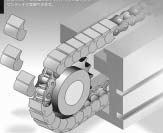Calculation of Chain Tension
Normally, to start with, tentatively decide the chain dimension to become applied referring to “Tentative determination of chain size”. Then, obtain “Theoretical chain stress (T)” (P213) for the tentatively determined chain, and multiply the value by “Speed coefficient (K)”, to get “Substantial chain tension (Ta)”. For security, the significant chain stress need to be reduced compared to the “maximum allowable tension” stated within the table of dimensions of respective chains. Consequently, the problem beneath must be content.
Safety situation of chain stress
Considerable chain tension (Ta) =Theoretical chain stress (T) ×Speed coefficient (K)
Considerable chain tension (Ta) <Maximum allowable stress
If this problem just isn’t happy, choose a larger chain by one size and re-calculate.
Tentative determination of chain size
qDetermine the mass (bodyweight) per unit length of components such as chain and attachment ωc (kg/m or kgf/m) assuming that it truly is 10 % from the mass (bodyweight) from the conveyed object ω1 (kg/m or kgf/m).
wIn reference to your calculation formulas on, receive “Theoretical chain tension (T)” (kN or kgf) and “Speed coefficient (K)”, and calculate “Substantial chain stress (Ta)” (kN or kgf).
eIn reference for the table of dimensions of chains,identify the minimal chain, whose “maximum allowable tension” is increased than the “Substantial chain tension (Ta)”, and regard it as “tentatively decided chain”.
Value of velocity coefficient (K)
The velocity coefficient (K) expresses the severity of operation condition in accordance to the traveling pace of chain since the problem turns into severer because the traveling pace of chain gets to be larger.
Multiply “Theoretical chain stress (T)” by “Speed coefficient (K)” to obtain “Substantial chain stress (Ta)”.

After you design many conveyor systems making use of modest conveyor chains, the next essential conditions have to be satisfied.
a. Chain stress: The actual tensile power in operation needs to be considerably reduce than the specified power with the chain.
b. Strength of loaded parts of chain: The real loads utilized to attachments, such as rollers of base chain, leading rollers, side rollers, and so on. in operation must be substantially smaller compared to the power of those elements.
c. Wear life of chain: Lubrication problems to ensure the dress in daily life of chain have to be fulfilled.
d. Sag adjustment of chain: The sag of your chain need to be stored optimum by stress adjusters, take-up devices, guides, and so forth.
e. Some others: Proper measures are taken to prevent rail dress in, machine vibration as well as other difficulties.
The next complement the above.